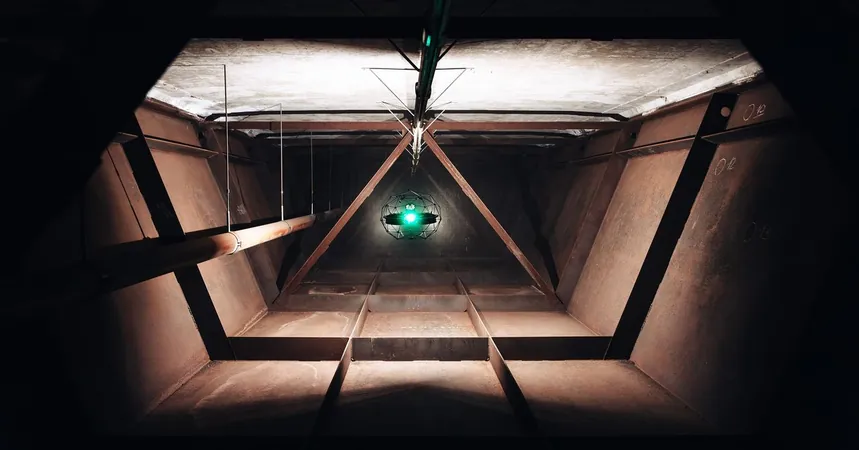
Drones to the Rescue: How High-Tech Innovation is Revamping Sewer Inspections
2025-04-28
Author: Wai
A Shocking Christmas Eve Incident
On Christmas Eve 2016, a household in Fraser, Michigan was jolted awake by an unusual ‘pop, pop, popping’ sound. Initially dismissed as harmless melting snow, the noise was a harbinger of disaster—a sinkhole was forming, causing the very structure of their home to crumble. In a heart-stopping twist, the incident led to the evacuation of not just that home, but several others, as a collapsed sewer interceptor threatened the integrity of multiple properties and a busy roadway.
The Demands of Infrastructure Maintenance
Vince Astorino, the Operations Director at the Macomb County Public Works Office, highlighted the severity of the situation: a critical 11-foot diameter sewer pipe had failed, disrupting the wastewater flow for around 800,000 residents. Emergency measures were taken swiftly to avoid a complete sewage disaster. But even after the situation was contained, it took nine months and a staggering $75 million to fully replace the damaged sewer line.
The Challenge of Traditional Inspections
With sewer lines often dark and cramped, routine inspections can be akin to navigating a labyrinth. Traditional methods involve teams of workers who face serious hazards, making the process time-consuming and costly. This is where modern technology steps in.
Enter the Drone Era
Meet the Elios 3 drone, a game changer in sewer inspections. Developed by Swiss company Flyability, this drone boasts a protective cage, robust impact-resistant design, and cutting-edge technology including a 4K camera and LiDAR capabilities. It can traverse these treacherous tunnels, capturing live 3D models and even detecting explosive gases.
Cost and Efficiency Revolutionized
Eloise McMinn Mitchell from Flyability has noted an impressive surge in demand for the Elios 3. The benefits are clear: inspections that once required at least four personnel and traffic diversions can now be executed by just two drone operators. The resulting cost reductions? An astounding average of 40%. With the drone, inspection stretches of up to 900 meters can be covered in a single day, as opposed to just 400 meters using traditional methods.
Macomb County Leads the Charge
In a bold innovation move, Macomb County adopted the Asio X drone alongside advanced software called SewerAI in May 2024. Previously, the county spent about $1 million every three years on inspections, but the new technology, costing around $100,000, has redefined the inspection landscape.
How Drones Work Their Magic
Equipped with powerful lighting and a 4K camera, the Asio X can document entire lengths of sewer pipes, collecting video, LiDAR, and even gas readings. Unlike some consumer drones, it’s manually controlled, requiring skilled operators to navigate through challenging environments. Once the footage is collected, it’s sent to SewerAI for rapid analysis, typically returning results within 24 hours—a dramatic improvement over past methods that could take months.
A Future of Continuous Improvement
Macomb County has set a precedent as Michigan's first to integrate drones with AI in underground inspections, earning accolades for its forward-thinking approach. Yet, according to Astorino, the quest for innovation continues. "We’re always exploring new ways to enhance our operations, especially in this tech-driven landscape," he explains.
Conclusion: A Brighter Future for Sewer Infrastructure
The integration of drones and AI not only protects communities from potential disasters but also restores confidence in aging infrastructure. In the quest for efficiency and safety, technology is proving to be our best ally.

 Brasil (PT)
Brasil (PT)
 Canada (EN)
Canada (EN)
 Chile (ES)
Chile (ES)
 Česko (CS)
Česko (CS)
 대한민국 (KO)
대한민국 (KO)
 España (ES)
España (ES)
 France (FR)
France (FR)
 Hong Kong (EN)
Hong Kong (EN)
 Italia (IT)
Italia (IT)
 日本 (JA)
日本 (JA)
 Magyarország (HU)
Magyarország (HU)
 Norge (NO)
Norge (NO)
 Polska (PL)
Polska (PL)
 Schweiz (DE)
Schweiz (DE)
 Singapore (EN)
Singapore (EN)
 Sverige (SV)
Sverige (SV)
 Suomi (FI)
Suomi (FI)
 Türkiye (TR)
Türkiye (TR)
 الإمارات العربية المتحدة (AR)
الإمارات العربية المتحدة (AR)